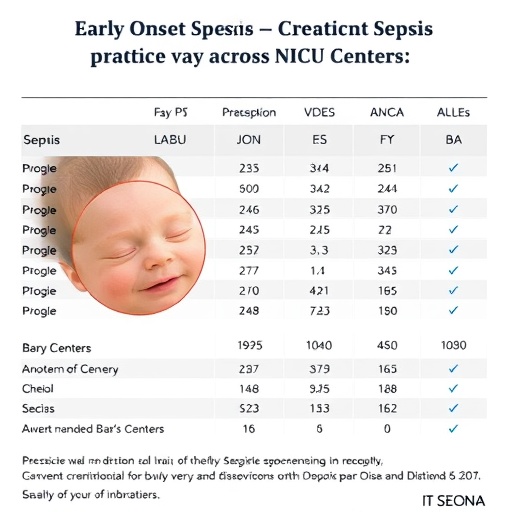In an era where antibiotic resistance looms as one of the foremost challenges in modern medicine, the management of suspected early-onset sepsis (EOS) in term infants remains a delicate balancing act. Recent research spearheaded by Joshi, Zangwill, Lee, and their colleagues has shed compelling light on how neonatal intensive care unit (NICU) providers across multiple centers navigate this clinical crossroads. Published in the Journal of Perinatology, their study intricately explores the evolving preferences and decision-making variability surrounding the use of antibiotics in newborns at risk of EOS, offering a nuanced perspective grounded in a multicenter antibiotic stewardship collaborative.
Early-onset sepsis in neonates, defined as systemic infection occurring within the first 72 hours of life, is notorious for its rapid progression and significant morbidity and mortality. Historically, clinical suspicion alone has often driven immediate empirical antibiotic administration, but concerns about overuse and consequent resistance have prompted a critical reexamination of these practices. The study by Joshi et al. confronts this issue head-on, providing a granular analysis of provider preferences through the innovative use of factorial vignettes—composite clinical scenarios designed to elicit nuanced responses and simulate real-world variability in clinical judgment.
The research methodology deserves special attention. By deploying factorial vignettes across several NICUs engaged in a structured antibiotic stewardship collaborative, the investigators simulated a controlled yet representative set of infant presentations suspicious for EOS. Providers were asked to indicate their preferred management strategy for each vignette, enabling the researchers to quantify patterns of antibiotic initiation or withholding and to detect shifts over time. This approach transcends mere survey data by integrating clinical complexity and contextual factors into the evaluative matrix.
.adsslot_LedEt3PSlB{ width:728px !important; height:90px !important; }
@media (max-width:1199px) { .adsslot_LedEt3PSlB{ width:468px !important; height:60px !important; } }
@media (max-width:767px) { .adsslot_LedEt3PSlB{ width:320px !important; height:50px !important; } }
ADVERTISEMENT
Findings from this multicenter inquiry reveal a striking heterogeneity in practice preferences, reflecting persistent clinical uncertainty amid evolving guidelines and stewardship efforts. While some centers showed a marked propensity to curtail antibiotic use when clinical indicators were equivocal, others exhibited more conservative tendencies, leaning toward empirical treatment even in borderline cases. Importantly, the study documents a gradual but discernible trend toward less aggressive antibiotic use as the stewardship collaborative progressed, suggesting that concerted efforts and shared decision frameworks may foster more judicious prescribing habits.
These observed practice variations are influenced by myriad factors. Provider experience, institutional culture, perceived medicolegal risks, and the availability of rapid diagnostics all interplay to shape decision-making. The research underscores how stewardship programs must not only disseminate guidelines but also address these underlying determinants to achieve meaningful change. Notably, the vignette-based approach uncovered that providers often weigh nuanced clinical features—such as maternal risk factors, infant gestational age, and laboratory findings—in complex, sometimes conflicting ways, highlighting the difficulty of creating one-size-fits-all protocols.
The impact of this study extends beyond merely characterizing the status quo. By illuminating shifts in preferences over the collaborative period, the authors provide empirical evidence that multidisciplinary, cooperative stewardship efforts can effectively recalibrate clinical thresholds for antibiotic initiation. This is particularly salient given the growing armamentarium of diagnostic and risk stratification tools, such as serial physical exams and molecular assays, which can support more tailored treatment paradigms.
The implications for neonatal outcomes and antimicrobial resistance patterns are profound. Curtailing unnecessary antibiotic exposure in this vulnerable population reduces the risk of adverse effects including alterations in the developing microbiome, potential toxicity, and the selection of resistant organisms. This contributes to better long-term health trajectories for neonates as well as broader public health benefits. However, the study also cautions against overly rigid protocols that might delay timely therapy in infants with truly invasive infections, underscoring the imperative of clinical vigilance.
From a technical standpoint, this investigation represents a significant advancement in the application of factorial vignette methodology within pediatric infectious disease research. The statistical rigour applied in analyzing vignette responses allows for the differentiation of provider and institutional effects, providing a roadmap for future studies seeking to dissect complex decision-making processes in healthcare. The data generated could inform machine learning models designed to forecast clinical decisions, thereby integrating human expertise with artificial intelligence to optimize care.
Moreover, the study’s multicenter design enhances its generalizability, capturing a wide spectrum of practice environments from academic tertiary care centers to community hospitals. This diversity facilitates the identification of regional and institutional factors that may drive antibiotic use patterns, enabling stewardship programs to tailor interventions accordingly. The collaborative model employed fosters knowledge exchange and shared ownership of stewardship goals, which is critical for sustained practice change.
An intriguing aspect highlighted by Joshi and colleagues is the relationship between provider characteristics and antibiotic prescribing preferences. Variables such as years of experience, specialty training, and previous exposure to stewardship education were all examined, revealing subtle trends that suggest targeted educational initiatives could further optimize decision-making. The research invites a reconsideration of how neonatal training programs incorporate stewardship principles and risk assessment skills into their curricula.
In terms of future directions, the study advocates for continued refinement of clinical prediction models for EOS combined with robust stewardship frameworks. Integration of rapid point-of-care diagnostics capable of ruling out infection early in the clinical course could revolutionize management, allowing for more precise antibiotic stewardship without compromising patient safety. Additionally, ongoing evaluation of practice patterns through tools like factorial vignettes can serve as a barometer for the effectiveness of interventions implemented over time.
It is also worth emphasizing the study’s contribution to the evolving narrative around personalized medicine in neonatology. While historical protocols have often been rigid, the evident variability in responses to complex clinical scenarios underscores the need for individualized risk stratification. Incorporating electronic health records data, genomics, and machine learning algorithms alongside clinician judgment promises to herald a new paradigm of precision stewardship in EOS management.
Finally, the ethical dimensions implicit in antibiotic stewardship in the NICU should not be overlooked. Decisions to initiate or withhold antibiotics in neonates hinge on risk-benefit analyses with profound consequences. Ensuring that stewardship collaborations are inclusive, transparent, and adaptive is essential for maintaining trust among providers, families, and the broader healthcare community.
In sum, this landmark study by Joshi et al. presents an indispensable resource for clinicians, researchers, and policymakers aiming to harmonize the dual imperatives of safeguarding neonates from sepsis and combating antibiotic resistance. By capturing the complexity of real-world decision-making and demonstrating the potential for collaborative transformation, it sets a benchmark for future stewardship endeavors in neonatal care.
Subject of Research: Provider practice preferences and variability in antibiotic use for term infants with suspected early-onset sepsis within a multicenter NICU antibiotic stewardship collaborative.
Article Title: Factorial vignettes describe suspected early onset sepsis practice variation in a multicenter NICU antibiotic stewardship collaborative.
Article References:
Joshi, N.S., Zangwill, K.M., Lee, H.C. et al. Factorial vignettes describe suspected early onset sepsis practice variation in a multicenter NICU antibiotic stewardship collaborative. J Perinatol (2025). https://doi.org/10.1038/s41372-025-02325-x
Image Credits: AI Generated
DOI: https://doi.org/10.1038/s41372-025-02325-x
Tags: antibiotic resistance in neonatesclinical decision-making variabilityearly onset sepsis managementempirical antibiotic administrationmulticenter neonatal studyneonatal infection outcomesneonatal intensive care unit challengesNICU antibiotic practicesprovider preferences in sepsis treatmentresearch on neonatal sepsissepsis risk in term infantsstewardship in antibiotic use





